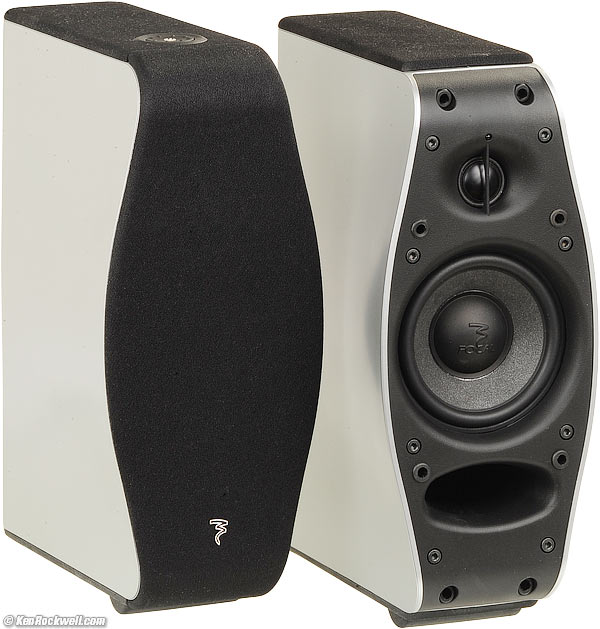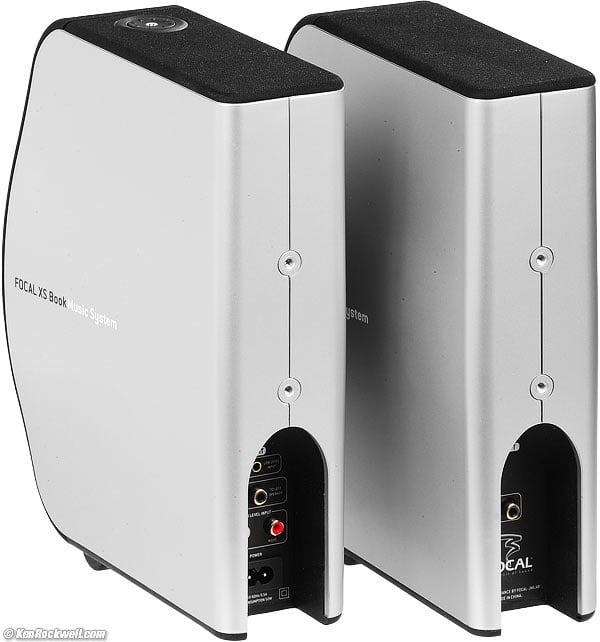Home Donate New Search Gallery Reviews How-To Books Links Workshops About Contact
Focal XS Book
Amplified Speakers
© 2012 KenRockwell.com. All rights reserved.
Intro Specs Performance Usage Recommendations More
Focal XS Book (4" 2-way, 20W x 2 internal amplifiers, about $400 the pair). larger. This free website's biggest source of support is when you use these links, especially this link to them at Amazon and at B&H Photo-Video when you get anything, regardless of the country in which you live. Thanks! Ken.
Rear, Focal XS Book. larger.
Connections, Focal XS Book. larger.
October 2012 All Reviews > Audio Reviews > Focal Reviews
Introduction top
Intro Specs Performance Usage Recommendations More
The Focal XS Book are a small pair of self-amplified speakers.
They excel at ease of use, vanishingly small size on a desktop, pleasant, undistorted sound with very low power consumption while delivering plenty of volume.
They have less distortion and are therefore more pleasant to listen to for extended periods on a desktop than the multi-thousand-dollar B&W Matrix 805. I can enjoy these XS Book all day, while after a few hours at close range I have to turn off my Matrix 805 from distortion-induced ear fatigue.
The XS Book are tiny speakers with no bass response. They try to hide their lack of bass by boosting the lower midrange and upper bass to make themselves sound fuller, which makes them less suitable for use with subwoofers which they so dearly need for music reproduction. For voice alone, they are excellent.
In a quiet environment on a desktop, their amplifiers have enough self-noise to cause audible hiss. It doesn't vary with the volume control setting.
These are made in China mostly of plastic.
With rubber bottoms, they sit on a desktop perfectly, and their integral power and volume control is easy to use on the top of the right speaker.
These look great on a desktop because they are so narrow. On opposite sides of my picture monitors, they pretty much become invisible.
You can plug your iPod, iPad, computer, TV or whatever directly into them; they have their own power amplifier built in. There is no digital input, just RCA and 3.5mm analog.
They draw very little power from the wall, only 3.6 watts at idle and 4 watts when played loudly. These are perfect for a solar-powered audio system used, say, on a sailboat. They draw 0.0 watts when off.
Specifications top
Intro Specs Performance Usage Recommendations More
Technology
Digital amplifier, 20 watts for each speaker. Passive internal crossover at 3 kHz.
Both amplifiers are in one speaker, and a cable is passed to the other speaker to drive it.
4" vented polyglass "woofer." As seen from the front, it only measures 3.5" diameter at the edges of the suspension.
3/4" (19mm) aluminum dome tweeter.
Impedance
Not relevant; these are self-amplified.
Sensitivity
700 mV, RCA input.
250 mV, 3.5mm input.
Frequency Response (rated)
50 ~ 22,000 Hz ± 3 dB.
-6 dB at 44 Hz.
Electrical Output Power
20 W for each speaker.
SPL
96 dB SPL, no qualifications.
Size
11 x 4.48 x 7.87" HWD.
281 x 114 x 200mm HWD.
Weight
5.5 pounds (2.5 kg).
Quality
Made in China, plastic case.
Included
Two speakers.
Generous 10' flat power cord.
5' (1.5m) mono RCA cable to drive left speaker.
5' (1.5m) mono RCA cable extender to enable more separation between speakers.
(1.5m) 3.5mm male-to-male input cable (iPods).
Performance top
Intro Specs Performance Usage Recommendations More
Sound
The Focal XS Book are very smooth and natural sounding, but never very exciting or interesting. They are pleasant and clean, but never with any depth, and there is no bass.
There are no obnoxious resonances to annoy you after days and days of listening to them all day, however the sound is always in a plastic-cased fog and never gets that clear for careful listening. These sound like the little Chinese plastic speakers they are, not the Focal SM9, which are bigger and more expensive, and sound so much better.
The XS Book's sound is very pleasant but distant, and never open or transparent.
There is a broad boost around a few hundred Hertz to try to make these little speakers sound bigger to casual listeners. They make male voice sound very big.
I'm not comparing these to Dell or other junk computer speakers, I'm evaluating them on the same level as multi-thousand dollar speakers like the B&W Matrix 805, Genelec or Dynaudio, which for $400, these XS book don't come close — but they are more pleasant to enjoy than some of the very expensive monitors.
Actually, I prefer the passive Focal Little Bird speakers driven with an outboard amplifier, crossover and stereo subwoofers to these XS Book; but that's a much more complex system.
Amplifier Response
Since the amplifier's left speaker output comes out of a cable, this makes it easy to measure the frequency response of the amplifier driving the speakers as an insight to how these are designed:
Focal XS Book Amplifier Response (NOT SPEAKER RESPONSE!) R&S UPL.
This was measured as the amplifier drove the passive left speaker. It is not the overall response of the speaker system; this is merely the shaped response of the amplifier driving a passive speaker.
I didn't measure at different levels to see if the bass EQ was variable or not.
As expected, we see a third-order high-pass filter working to extend the bass to about 70 Hz, rapidly dropping off below that to avoid woofer excursion in what ought to be an overall seventh-order system (fourth-order speaker and third-order filter). The amplifier drops at 18 dB/octave below 60 Hz, and the speaker probably drops off at 24 dB/octave.
The dip at 1.7 kHz, boost at 3.8 kHz and dip at 11 kHz are to smooth the response of the passive speaker. This lets the system work far more efficiently than attempting to correct these in a passive crossover network.
Likewise, the boost towards the low end also helps skew the speaker's overall response as desired while allowing greater overall sensitivity, instead of passively attenuating the tweeter as is usually done.
Gain and Loudness
These go more than loud enough, although there isn't that much excess gain to play soft sections that loudly.
There is a volume police! If you try to play it so loud that it would distort, an invisible electronic hand quickly turns down the volume automatically and leaves it as loud as it can without distorting.
These are designed to have loads of output and efficiency around a few hundred Hertz (lower midrange and upper bass), and they do.
Noise
Not acceptable for hi-fi use is that the internal amplifiers are audibly noisy within a few feet. Used on a quiet desk you'll always hear slight amplifier hiss.
The noise is unchanged regardless of the level control's setting.
Bass
There is no bass from these tiny speakers on a desktop, just an emphasized low midrange and upper bass to try to fool the innocent.
Bass is strong to 100 Hz and sort of usable to 80 Hz, but very buzzy below
80 Hz.
There is some output to 65 Hz, and none below that as born out not only by my listening, but the fact that the amplifier cuts-out below 60 Hz as measured. I don't believe the specifications!
There is more bass if you get further away from these speakers in a larger room.
As a bass player, I miss the bass, and these speakers don't integrate well with subwoofers because of their added warmth in the lower midrange. I'd rather listen to the thumpy sound of a Bose satellite system than these. Bass is much more important to me than to most people.
Power Drain
As covered above, they draw 0.0W off, 3.6W at idle and only 4W player loud.
Played stupid loud, I couldn't draw more than 5 to 6 W from the wall. Ignore the "50W" marking; if you're using these in a low-power system, like a solar-powered inverter in your backpack, these make a lot of sound with very little power drain.
There is no auto power shutoff if the music stops. These stay on until turned off.
Materials and Mechanics
They are all plastic.
The woven plastic cables are not that convincing; they don't feel like cloth.
Ergonomics
These are very nice; just pop them on your desk and the rubber bottoms position them perfectly and don't damage your desk.
They are an ideal shape: tall and deep to get some box volume, and so narrow that they disappear.
The grilles come off and on.
There are no real instructions, and none are needed; just plug and play.
Usage top
Intro Specs Performance Usage Recommendations More
Plug in your analog audio: iPad, computer, iPod, radio, preamp or whatever. If you want to play wirelessly from you iPad, iPod, Mac or whatever, use an Apple Airport Express.
Plug the RCA cord from the right speaker to the left speaker. Use the included extension if needed, and if you need more distance as I did, any 99¢ RCA patch cord works fine.
Plug into the wall.
Press the top button to turn on the speakers, and the white LED lights more brightly. The white pilot LED is semi-obnoxious: it's bright when on, and dimmer when off. There is no standby position; just OFF or ON.
Adjust the volume to taste.
The power and gain switch is easy to work by feel on the top of the right speaker. It controls audio over the full range. Use it to set the system level and match to subwoofers; it responds too slowly as a moment-to-moment volume control.
I always leave these turned on. They don't draw enough power to make it worth my while to turn off overnight. If I kill the power to the whole system, they always wake up in OFF mode. In OFF, the white pilot light glows dimly, confusing me at first thinking they were on.
Recommendations top
Intro Specs Performance Usage Recommendations More
These are great little plastic speakers for where you need them to amplify themselves and just disappear. They have no bass; I'd prefer the sound from a cheaper satellite system with a bad subwoofer than these speakers run with no subwoofers at all. These speakers are fine for voice, and sound fuller played in a larger room as opposed to a desktop on which I used them.
These are very pleasant speakers to hear all day; they never call attention to themselves.
If you've found my efforts reviewing these helpful, my biggest source of support is when you use these links, especially this link to them at Amazon and at B&H Photo-Video when you get anything, regardless of the country in which you live. Thanks! Ken.
More top
Intro Specs Performance Usage Recommendations More
Help me help you top
I support my growing family through this website, as crazy as it might seem.
If you find this page as helpful as a book you might have had to buy or a workshop you may have had to take, feel free to help me continue helping everyone.
If you've gotten your gear through one of my links or helped otherwise, you're family. It's great people like you who allow me to keep adding to this site full-time. Thanks!
If you haven't helped yet, please do, and consider helping me with a gift of $5.00.
As this page is copyrighted and formally registered, it is unlawful to make copies, especially in the form of printouts for personal use. If you wish to make a printout for personal use, you are granted one-time permission only if you PayPal me $5.00 per printout or part thereof. Thank you!
Thanks for reading!
Mr. & Mrs. Ken Rockwell, Ryan and Katie.
Home Donate New Search Gallery Reviews How-To Books Links Workshops About Contact






